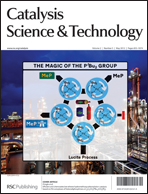The intriguing research toward the exploitation of ceria-based materials for various applications has been growing significantly. In the present investigation, we describe the preparation, characterization and utilization of CeO2–La2O3 (CL) and CeO2–La2O3/SiO2 (CLS) solid solutions for the synthesis of two industrially useful chemicals namely 4-methylpent-1-ene and dehydroacetic acid. Coprecipitation and deposition coprecipitation from ultrahigh dilute solutions were used for the synthesis of CL and CLS catalysts, respectively. The physicochemical characterization has been achieved with the help of various techniques namely X-ray diffraction (XRD), BET surface area, transmission electron microscopy (TEM), UV-visible diffuse reflectance spectroscopy (UV-vis DRS), Raman spectroscopy (UV-RS and Vis-RS), X-ray photoelectron spectroscopy (XPS) and temperature programmed desorption (TPD) measurements. The structure–activity relationships helped to correlate different parameters that are necessary for obtaining desired products in good yields. The inclusion of silica support has an optimistic influence on the acid–base properties of the ceria–lanthana, in terms of both amount and strength of sites. The presence of silica not only manipulates the acid–base properties but also causes numerous benefits, for instance, it improves the dispersion, stabilizes the active component against sintering and enriches the oxygen vacancy concentration. The meticulous analysis of characterization and activity studies revealed the significant role of acid–base sites in directing the desired products. Interestingly, the CLS catalyst has shown better performance in the production of both 4-methylpent-1-ene and dehydroacetic acid compared to the unsupported CL sample due to well-balanced acid–base sites.

You have access to this article
 Please wait while we load your content...
Something went wrong. Try again?
Please wait while we load your content...
Something went wrong. Try again?


 Please wait while we load your content...
Please wait while we load your content...